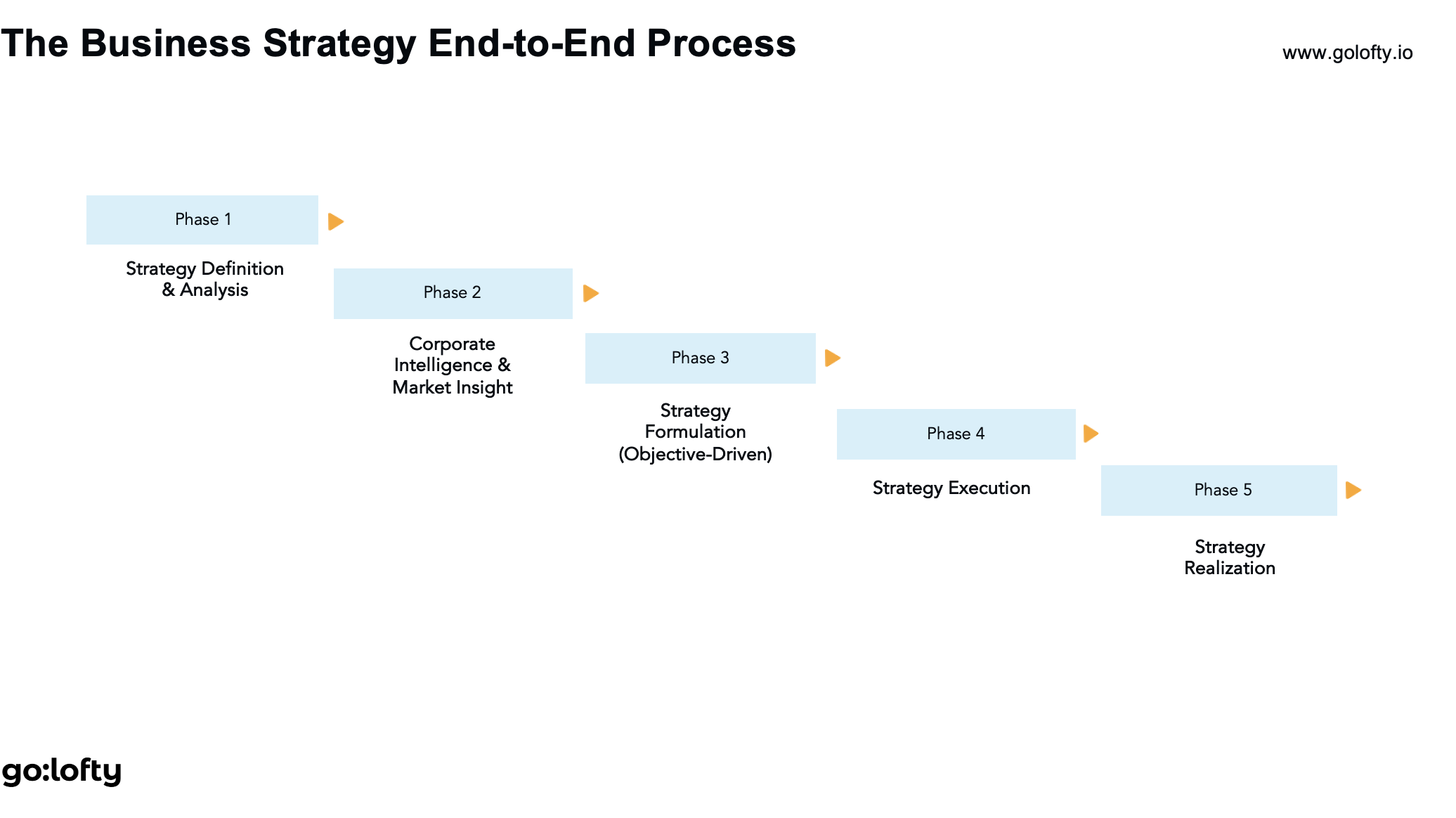
The Business Strategy End-to-End Process: Building a Sustainable Path to Growth
In an increasingly competitive and dynamic marketplace, having a well-defined business strategy is no longer optional—it’s a necessity. A strong business strategy serves as a guiding compass, directing an organization toward its long-term goals while addressing market challenges and opportunities along the way. However, developing and executing a successful strategy requires more than just setting high-level objectives. It demands a structured, end-to-end approach that integrates various elements such as market analysis, strategic planning, operational alignment, and continuous execution.
In this article, we will walk through the Business Strategy End-to-End Process and explore why establishing Strategy as a Function is critical for organizational success.
The 5 Phases of the Business Strategy End-to-End Process
The journey from strategic vision to execution involves several key phases, each of which plays a vital role in ensuring the organization is well-positioned for growth and success.
Phase 1: Strategy Definition & Analysis
The first phase involves laying the groundwork for strategy development by conducting a comprehensive analysis of the organization’s current state, competitive environment, and market opportunities.
- Company Vision: This step is about defining or refining the company’s vision and long-term goals. It serves as a foundation for developing strategic objectives that are aligned with where the company wants to go.
- Competitive Analysis: Conducting a thorough analysis of competitors, including their strengths, weaknesses, market positioning, and strategies, helps identify gaps and opportunities in the market.
- Company Health Check: This is an internal assessment of the company’s resources, capabilities, and performance. Understanding the organization’s strengths and weaknesses enables the strategy to build on existing assets while addressing key challenges.
By the end of this phase, the organization should have a clear understanding of its market position, competitive landscape, and internal capabilities, which forms the basis for strategic planning.
Phase 2: Corporate Intelligence & Market Insight
This phase involves gathering market intelligence and developing insights that will inform the organization’s strategic decisions.
- Market Analysis: An in-depth analysis of market trends, customer behavior, and emerging opportunities is conducted to identify areas where the company can gain a competitive advantage.
- Corporate Intelligence: Gathering intelligence on industry developments, competitors, and technological advancements helps ensure that the strategy is aligned with future trends and challenges.
- Opportunity Identification: With the insights gathered, the organization can identify specific opportunities for growth, expansion, or innovation.
Having a solid base of corporate intelligence and market insight ensures that the strategy is data-driven and responsive to the current and future market environment.
Phase 3: Strategy Formulation (Objective-Driven)
Once the analysis is complete, the next phase is Strategy Formulation, where the organization defines clear objectives and develops strategic initiatives to achieve them.
- Corporate Objective-Setting: Establishing clear, measurable objectives based on the company’s vision and market insights. These objectives will serve as a roadmap for all strategic initiatives.
- Customer Insights (B2B and B2C): Understanding customer needs and expectations is crucial. Whether the company operates in B2B or B2C environments, this step ensures that the strategy aligns with customer demands.
- Portfolio & Offering: Developing a product or service portfolio that aligns with strategic objectives and meets market needs is vital for creating value and differentiating from competitors.
- Operating Model: The operating model outlines how the organization will deliver value. It includes key elements like resource allocation, process optimization, and organizational structure.
- Branding: Ensuring that the company’s brand aligns with its strategic objectives and resonates with its target audience is essential for building long-term relationships with customers.
By the end of this phase, the organization should have a comprehensive strategy with clear objectives, customer insights, and an operational model that supports long-term growth.
Phase 4: Strategy Execution
The Strategy Execution phase involves translating the strategic plan into actionable initiatives that can be implemented across the organization.
- Strategic KPIs & Success Criteria: Defining key performance indicators (KPIs) to measure the success of the strategy ensures that the organization can track progress and make adjustments as needed.
- Strategy Initiatives: Specific initiatives are developed to achieve the strategic objectives, ranging from product development to market expansion and operational efficiency.
- Business Case for Change Initiatives: Each strategic initiative should be supported by a business case that outlines its expected outcomes, required resources, and potential risks.
The success of the strategy hinges on effective execution. This phase ensures that all initiatives are aligned with the strategic objectives and that progress is continuously monitored.
Phase 5: Strategy Realization
The final phase of the strategy process focuses on ensuring that the strategic goals are realized and that the organization continues to adapt and evolve.
- Strategy Implementation: The initiatives are implemented across the organization, with a focus on achieving the defined KPIs and success criteria.
- Adaptation and Continuous Improvement: The business environment is constantly changing, and organizations must be able to adapt. Continuous monitoring of the strategy’s performance allows for ongoing adjustments to keep the organization on track.
By the end of this phase, the organization should have successfully implemented its strategic initiatives and be well-positioned for future growth.
The Importance of Establishing Strategy as a Function
While many organizations develop strategies, far fewer establish Strategy as a Function—a critical mistake that limits their ability to execute effectively and sustain success. Let’s explore why embedding strategy into the core of the organization is so important.
Ensures Continuity and Alignment
Strategy is not a one-time activity but an ongoing process. Establishing strategy as a function ensures that strategic planning, execution, and review are continuous activities within the organization. It also creates a clear line of alignment between the organization’s vision, goals, and day-to-day operations.Facilitates Agile Decision-Making
In today’s fast-paced environment, businesses must be agile and able to respond to new challenges and opportunities quickly. A formal strategy function ensures that the organization has the systems and processes in place to adapt its strategy in real-time.Improves Cross-Functional Collaboration
Strategy impacts all areas of the organization—from marketing and sales to operations and human resources. A dedicated strategy function ensures that all departments are aligned with the overall business objectives and are working together towards common goals.Enhances Performance Monitoring
Establishing strategy as a function provides a framework for continuous performance monitoring. By regularly tracking KPIs and reviewing progress, the organization can identify areas where the strategy is succeeding and where it may need to be adjusted.Supports Sustainable Growth
Finally, embedding strategy into the organization’s core supports long-term, sustainable growth. By having a dedicated function focused on strategy, the organization can ensure that its strategic initiatives are not only implemented but also scaled to support future success.
The Business Strategy End-to-End Process provides a structured approach to developing and executing a successful strategy, from initial analysis to final implementation. However, the true key to success lies in embedding strategy into the very fabric of the organization. By establishing Strategy as a Function, businesses can ensure continuous alignment, agility, and sustainable growth in an ever-evolving marketplace.
At Go:lofty Consulting, we specialize in helping businesses develop and execute strategies that drive growth and long-term success. Contact us today to learn how we can help you build and implement a robust business strategy.




